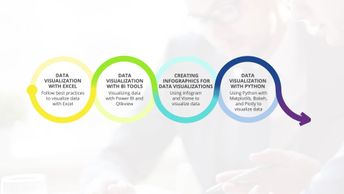Final Exam: Data Visualization with Excel - add labels to a box-and-whisker plot, create a box-and-whisker plot with two sets of boxes and whiskers grouped based on a category, and perform various formatting operations on this plot
- classify the advantages and disadvantages of variants of line charts, such as stacked line charts, 100% stacked line charts, and 3D line charts
- create a basic area chart, illustrate a major disadvantage of an ordinary area chart, then change the opacity of areas to overcome this problem
- create a basic line chart, experiment with the data label options in a line chart, and change the fill color of the line in a line chart
- create a Gantt chart out of a basic stacked bar chart
- create an Excel Open-High-Low-Close stock chart, also known as a candlestick chart, to visualize financial data
- create band charts to quickly visualize the trend in a line chart
- create various kinds of clustered column charts and stacked column charts, hide a selection of rows, and hide a chart using that feature
- create various special histograms
- customize various aspects of a bar chart, such as the axis configurations, the overlap between the bars, and the size of the bars
- display the relationship between two variables and understand what kind of model might be most useful to represent that relationship
- format the background fill, texture, axes, and title of a column chart and line chart and change the position of two charts relative to each other
- illustrate the use of the gradient fill feature, change various aspects of a gradient-filled line chart, and work with radial gradients and linear gradients
- import data from a PDF document and a Microsoft Access database as well as all files from a folder into Excel
- list the best practices while building charts and visualizations
- open up Microsoft Excel and read in data from an Excel workbook and a CSV file
- recall the right special case for Heatmaps, Funnel Charts, Sunburst Charts, and Sankey Charts
- recall why data visualization is important in this age of big data
- use a radar chart to visualize the multivariate ordinal data and illustrate the advantages and disadvantages of radar charts
- visualize the trend of a stock's performance based on high, low, and close values over a specific period using the Excel High-Low-Close stock chart
|


